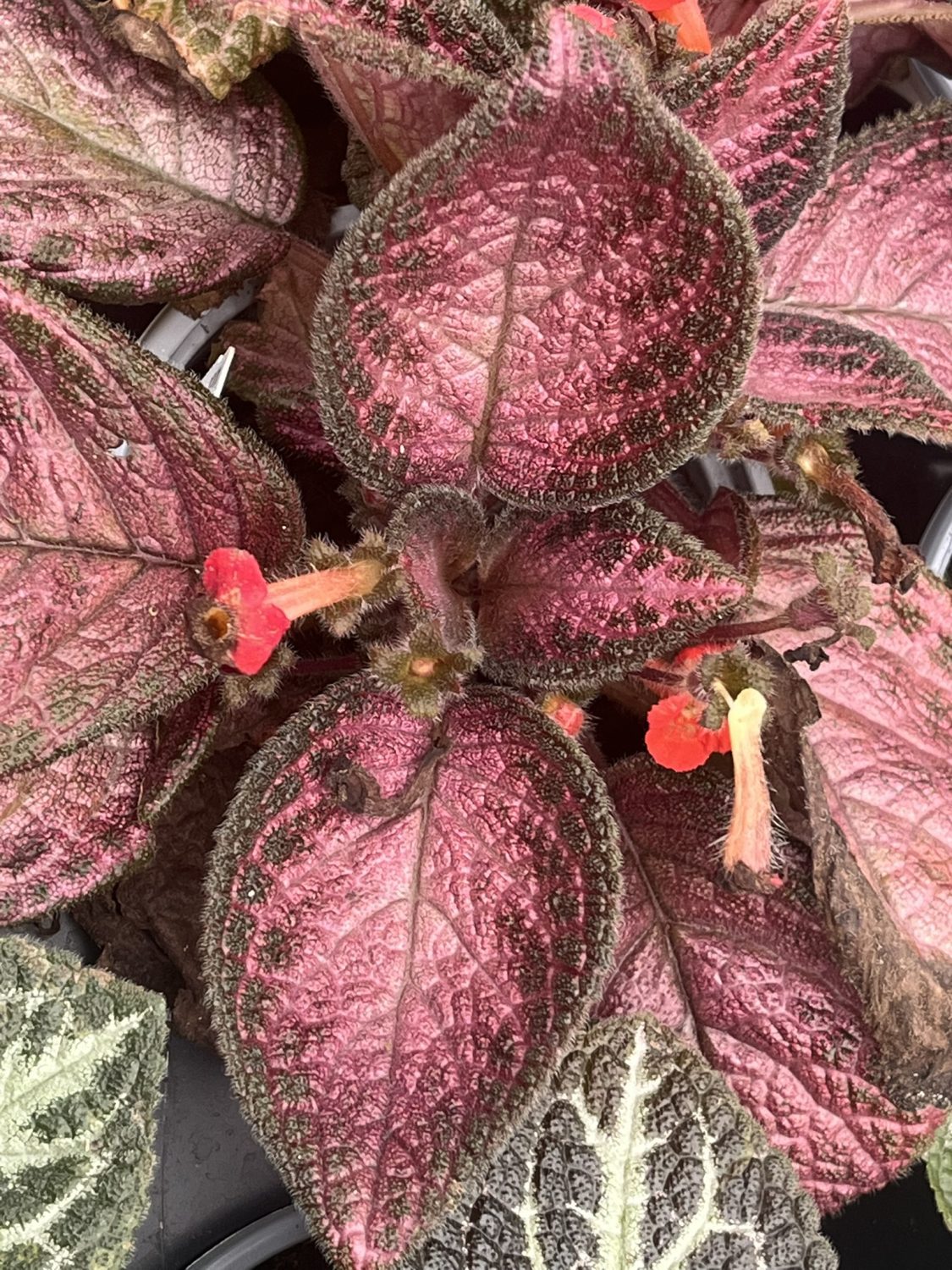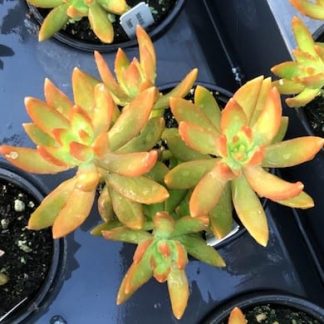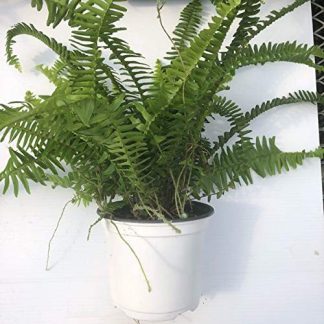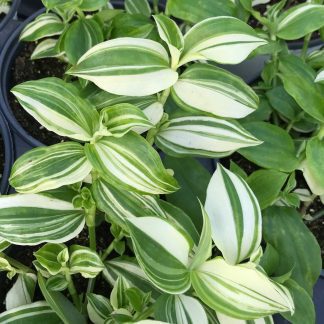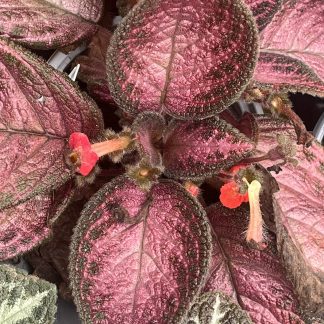Description
Episcia cupreata ‘Alice’ — The Velvet Glow for Bright, Happy Rooms
Meet ‘Alice’: Soft Leaves, Easy Rhythm, Everyday Color
We love plants that feel calm the moment you see them. Episcia cupreata ‘Alice’ does that with grace. The leaves are velvety and low, with a soft sheen that catches the light. Silvery-green centers blend into deeper green edges. Delicate tubular blooms—often coral, red, or warm orange—pop against the foliage like tiny lanterns. In other words, ‘Alice’ brings glow without glare. We get color, texture, and movement in a compact plant that thrives in our everyday spaces.
Instead of a fussy showpiece, ‘Alice’ is a friendly companion. It spreads with gentle runners, fills a pot fast, and forgives small mistakes. But most of all, it rewards simple, steady care with a lush, lived-in look.
Fast Facts (So You Can Place It Right)
- Botanical name: Episcia cupreata ‘Alice’
- Common name: Flame Violet ‘Alice’
- Light: Bright, indirect; avoid harsh midday sun
- Water: Keep evenly moist; let the top ½ inch dry between drinks
- Humidity: Medium to high (50–70% ideal)
- Temperature: 65–80°F; protect from drafts
- Growth habit: Low, spreading rosettes with stolons (runners)
- Best spots: East or bright north windows, open shelves, terrariums
- Container: Shallow, well-drained pots or small hanging baskets
Why ‘Alice’ Stands Out
- Velvet foliage with elegant contrast. Silvery centers and dark green margins create a soft, quilted look.
- Compact yet full. Runners branch and fill quickly, creating a plush cushion.
- Frequent blooms. Warm-toned flowers rise above the leaves through long seasons.
- Easy care indoors. Loves steady moisture, bright shade, and normal home temps.
- Terrarium-friendly. High humidity brings deeper color, thicker leaves, and more vigor.
The Look: Silver Sheen, Gentle Texture, Quiet Drama
‘Alice’ doesn’t shout. It glows. The leaf surface is velvety, which makes light roll across it like a ripple. Silver in the center brightens the plant even in low corners. Darker edges frame each leaf like a fine border. When multiple rosettes grow together, you get a soft, layered mound that spills over the pot. Then the blooms appear—small, tubular, and cheerful—and the whole plant feels complete. Foliage and flowers play together, instead of competing.
After more than a few weeks of simple care, you’ll notice new runners reaching out. Each runner ends in a baby rosette. That’s ‘Alice’ building fullness. Guide a few runners across the soil to fill bare spots. Let the rest drape. You set the style.
Light: Bright and Gentle Wins
Think “forest edge” light. Place ‘Alice’ near an east window for soft morning sun or a bright north window for all-day glow. In a south or west window, add a sheer curtain to soften the rays. If leaves look washed out or crisp, the light is too strong. If the pink blush (in stems or new leaves) fades and the plant stretches, it wants a bit more light. Aim for a consistent, indirect brightness.
Grow lights? A simple LED bar 12–18″ above the plant for 10–12 hours per day works well. Keep it bright, not blazing.
Water: Even Moisture, Not a Swamp
Episcia roots are shallow and love a steady rhythm. Water when the top ½ inch feels dry to the touch. Use room-temperature water and pour around the rim, not into the crown. Let excess drain. Instead of long droughts and heavy soaks, think small, regular drinks. Your reward: thick leaves, tight internodes, fast runners, and frequent blooms.
Pro tip: A cachepot system helps. Keep the plant in a nursery pot and slip it into a decorative outer pot. The air gap tempers moisture swings.
Humidity and Temperature: Cozy and Calm
‘Alice’ loves a humid hug. Aim for 50–70% humidity. A small humidifier nearby, a pebble tray with water, or a cluster of plants raises moisture in the air. Keep temps between 65–80°F. Avoid cold drafts, AC blasts, and heaters. Warm and steady is the goal. In drier homes, you’ll still succeed—just lean into consistent watering and an airy mix.
Soil and Potting: Airy Mix, Shallow Home
Use a light, springy blend that drains fast yet holds gentle moisture. Try this simple mix:
- 2 parts high-quality potting soil
- 1 part perlite
- ½ part coco coir or fine orchid bark
Choose a shallow pot with drainage holes. Episcia roots near the surface and spreads laterally. Repot in spring when the plant dries too fast, looks crowded with runners, or you want a wider bowl for a fuller cushion.
Fertilizer: Feed lightly in spring and summer with a balanced liquid fertilizer at ¼ strength once a month. In fall and winter, slow down or pause.
Growth Habit: Runners That Build a Plush Cushion
‘Alice’ makes stolons—slender runners with baby rosettes at the ends. When a rosette touches soil, it roots. In other words, the plant clones itself and thickens the pot. You control the shape:
- For fullness: Pin runners onto bare soil and let them root.
- For cascade: Let runners trail from a basket or shelf for soft drape.
- For tidiness: Trim the longest stolons and tuck tips back into the mix.
Propagation: Pin, Root, Snip, Plant
- Pick a healthy runner. Choose a baby rosette with several leaves.
- Pin it down. Rest it on moist soil in the mother pot or a small nursery pot. A paperclip or hairpin works.
- Wait and watch. Keep evenly moist. In warm, bright conditions, roots form in 1–3 weeks.
- Snip and pot. Cut the stolon, then move the new plant where you want it.
- Grow and glow. Keep light bright and gentle to encourage branching and blooms.
Styling Ideas: Small Spaces, Big Comfort
- Shelf softener: Place ‘Alice’ at eye level and let runners drape. The silver centers catch light and calm the corner.
- Coffee-table bowl: A shallow ceramic bowl turns foliage into living décor—quiet but rich.
- Terrarium nook: In a spacious terrarium with airflow, ‘Alice’ becomes a lush foreground. Trim lightly to keep paths open.
- Mixed hanger: Pair with a simple green trailer for contrast. ‘Alice’ provides shimmer; the partner provides flow.
Troubleshooting: Quick Reads, Easy Fixes
- Faded color or leggy growth: Light is too low. Move closer to bright, indirect light or extend grow-light hours.
- Crisp edges or dull leaves: Light too strong or air too dry. Add a sheer curtain, raise humidity, or adjust distance from grow lights.
- Soft, droopy center: Overwatering or dense soil. Refresh the mix, improve drainage, and let the top layer dry before the next drink.
- Tiny webs or stippling: Spider mites in dry air. Rinse leaves, raise humidity, and treat as needed.
- Cottony bits in leaf bases: Mealybugs. Dab with 70% isopropyl alcohol using a cotton swab, and repeat weekly until clear.
Most issues resolve with a small tweak to light, water, or airflow. ‘Alice’ responds fast when the basics are right.
Who Will Love ‘Alice’
- New plant parents who want a forgiving, rewarding plant with quick feedback.
- Collectors who enjoy Gesneriads and fine foliage with a soft sheen.
- Small-space dwellers who need a compact plant that still makes a statement.
- Terrarium fans who want a humidity-happy plant that stays neat with trimming.
- Gift givers seeking a pretty, low-stress plant that travels well and roots easily.
Care Calendar (Simple, Repeatable)
- Spring: Repot if needed. Start monthly feeding at ¼ strength. Train runners for shape.
- Summer: Maintain even moisture. Trim lightly to keep a cushion or cascade. Enjoy frequent blooms.
- Fall: Ease off feeding. Keep humidity steady as indoor heat returns.
- Winter: Bright light, lighter watering, warm room temps, and draft protection.
Frequently Asked Questions
Will ‘Alice’ bloom indoors?
Yes. In warm, bright conditions, you’ll see steady flowers through the growing season.
Can I grow it under lights only?
Absolutely. Place an LED grow bar 12–18″ above the plant for 10–12 hours per day. Keep the leaf surface warm, not hot.
How often should I water?
Check twice a week. Water when the top ½ inch of mix is dry. Avoid letting the plant sit in water.
Is it pet-friendly?
As with any houseplant, keep out of reach of pets that chew. Episcia is not typically listed as highly toxic, but we always play it safe.
How do I make it fuller?
Pin runners onto bare soil. Once they root, snip the stolon and let each new rosette branch. Rotate the pot every week for even growth.
What Makes ‘Alice’ a Keeper
After more than a few weeks with ‘Alice’, we notice a pattern. The routine feels easy. The plant looks better each month. Leaves thicken, runners multiply, and blooms keep appearing. Instead of demanding attention, ‘Alice’ rewards consistency. A little light. A little water. A little warmth. That’s the magic. It’s calm beauty, every day.
And when friends visit, they will point to it. They will ask for a piece. You’ll smile, snip a runner, and share a living gift. That’s how plants turn care into connection.

